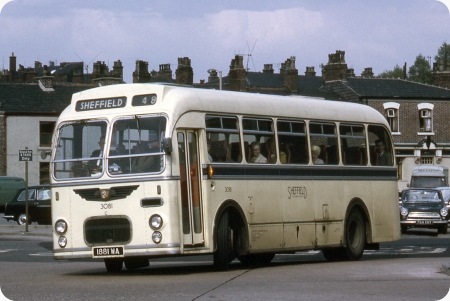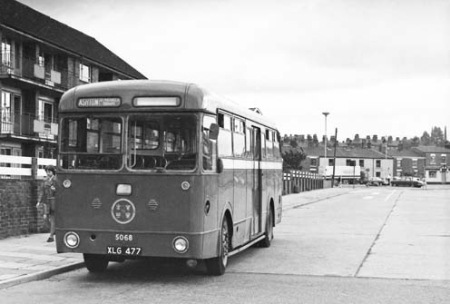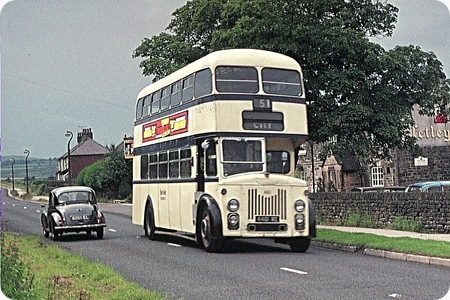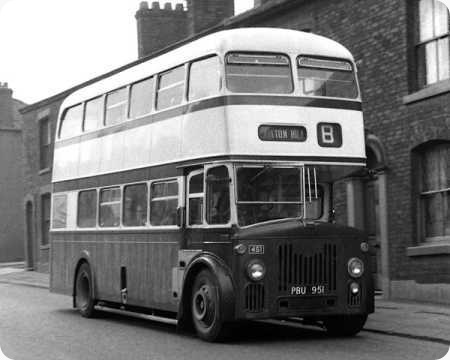
Copyright Roger Cox
Sheffield Corporation
1961
Leyland Leopard L1
ECW C41F
Here is a colour shot of 1881 WA, No. 3081, a sister vehicle to the Ian Wild posting of 1882 WA, No. 3082 in June 2011. The photo was taken in the early part of 1970, though I cannot now identify the location. As John Stringer says in a comment to 1882 WA this bus passed to the Calderdale fleet via Todmordon JOC together with its two stable mates, 1880/2 WA. I always admired this ECW "MW" body style for its restrained elegance and excellent finish, well above the standards of some of the contemporary "commercial" competitors.
Photograph and Copy contributed by Roger Cox
———
15/01/12 – 07:21
Agree fully with Roger about the ECW body. Although I’m a Burlingham and Weymann man, I always thought the ECW Leopards were the best looking of the lot in Sheffield. [This ought to be tagged Sheffield JOC – they weren’t owned by the Corporation.]
I went to music college in Manchester in 1971 – by which time the 48 was taking the Stocksbridge, Flouch, Woodhead route to Manchester. With the disbandment of the JOCs, although technically a joint route with North Western, by 1971 only NWRCC were running the mileage. 1968/70 AEC Swifts were also running the 48 in the last months of operation.
I suspect the photo was taken on the Manchester side of the Pennines. By the way it’s leaning I’m tempted to suggest that maybe it’s leaving Ashton Bus Station?
David Oldfield
———
15/01/12 – 12:05
I well remember these buses along with the Weymann and Burlingham bodied examples working the 48 Manchester service. They used to have a 15 minute refreshment stop at The Dog & Partridge at Bordhill, a mile up the road from Flouch. During the 1950’s and 60’s my aunt and uncle kept this pub and I used to spend my summer school holidays there. Several times in the late sixties the friendly crews would take me to Manchester with them or I would go to Sheffield with my aunt for an afternoon out, we never paid any fares!
I still have a letter the Sheffield General Manager sent them thanking them for the hospitality they had shown the crews and passengers over the years when they left the pub in 1968.
I don’t ever remember it being a joint service with NWRCC at this time though.
Eric
———
15/01/12 – 12:12

The location is definitely Ashton Bus Station. The attached photo shows the same backdrop. The pub which is the most prominent of the building is the Ladysmith. The view has changed significantly with the building of a new civic centre on the open land in the near background and the complete remodelling of the bus station.
The bus is former SHMD 77, later renumbered 108 and (as seen here) SELNEC 5068. This bus lasted longer in SELNEC days than might be expected and is shown here on 6th August 1971. It is an Atkinson PL745H with Northern Counties B34+27C bodywork. The present tense is relevant as the bus survives in preservation, albeit not very actively (I repainted it in 1976 and it never ran so adorned!). My previous negative (which I didn’t choose as it doesn’t show the background as well) shows it overtaken by Ashton 44, a front-entrance PD2 which is also preserved.
David Beilby
———
15/01/12 – 15:00
I may have said it before but it surprises me that this service hasn’t been restored. Presumably there was a time when it was unviable commercially, but today with vast numbers of people, particularly students, travelling across the Pennines and the rail service bursting at the seams, I would have thought it could be a lucrative service now. With Stagecoach having a presence in Manchester and Sheffield (and Barnsley too) the logistics are there although perhaps the fact that they are involved in part of the rail service precludes them from doing it.
Chris Barker
———
19/01/12 – 05:39
I’m sure the 48 wasn’t in the North Western timetable when I lived in Manchester (up until 1968), unlike the other two Sheffield-Manchester services, the (X)39 via Snake and (X72) via Castleton. Could it be that it never was a joint service, but was taken over by North Western when SJOC disappeared?
Peter Williamson
———
19/01/12 – 10:54
North Western took it over sometime 1970/71 following the disbandment of the JOCs. They were sole operator by the time I started my student days in September 1971. [A measly two round trips a day during the week.] It was part of agreement with some routes so that the Corporation could "keep" routes – even if they didn’t "run" them. By the end, I think the joint fiction had ended in fact.
David Oldfield
———
22/01/12 – 15:55
When the Sheffield JOC was disbanded, 48 became a joint route for the first time. The PSV Circle fleet list suggests that Yorkshire Traction became a joint operator, along with Sheffield Corporation and North Western, but, if so, this would just have been for licensing purposes as I’m fairly sure they never ran on the route.
Geoff Kerr
———
23/01/12 – 07:26
You’re absolutely right, Geoff – and I also remember the Tracky connection, but they never actually ran it.
David Oldfield
———
24/01/12 – 15:49
The writing was on the wall by November 1969. The 48 was still running, according to the Sheffield Transport time table, as One Man Operated service, the timetable notation of "subject to alteration" said it all. I have wonderful memories from the 1940’s of the 48 when it was not unknown for a convoy of 2/3 Weymann bodied Leylands to depart from the old Midland Railway Station. Tea and buns at the Dog & Partridge were all part of the treat. We and others did our family clothes shopping in Manchester after the Luftwaffe had done a demolition job on the Sheffield City Centre
Jerry Wilkes
———
30/01/12 – 16:26
Hi, I have a South Yorks fare book, issue 1, August 1974. It lists all the routes operated at that time. Is it of use to anyone? Now I have found this site, I will post many memories & questions on busses in the 50s & 60s. My dad was a bus driver on the 33, 34,35,36 bus routes out of Bramall Lane depot. He used to do the 12 Chesterfield route.
Andy Fisher
———
31/01/12 – 07:57
Andy. Another Sheffielder. Welcome. The West Yorkshire lot are a friendly enough bunch – but I think they still outnumber us!
David Oldfield
———
01/05/12 – 20:05
I have many happy memories of The Dog and Partridge !! Never travelled there by bus, unless we did so when I was very young and I have forgotten. However, when I was growing up my paternal grandparents had many relatives living in Lancashire, particularly around the St. Helens area and we always used to make a refreshment stop at that pub, in both directions when travelling from the Bircotes/Harworth area to Lancashire. I distinctly remember the ham sandwiches, which were, by far, for some reason, the best I had ever tasted at the time. They must have been good, I can almost taste them now, and that was 50+ years ago. Thank you all for mentioning this pub, brings back so many happy memories, and the last thing I expected when perusing a bus enthusiasts website.
Trevor Evans




